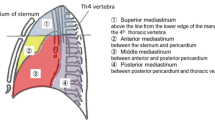Abstract
Purpose
Airway obstruction caused by lymphatic malformation (LM) in the head and neck may require a tracheostomy. We present the results of our analysis of a nationwide survey on the indications for tracheostomy in children with head and neck LM.
Methods
We analyzed data in relation to tracheostomy based on a questionnaire about 518 children with head and neck LM without mediastinal involvement.
Results
Tracheostomy was performed for 43 of the 518 children. Most (32/43) of these children were younger than 1 year of age and the tracheostomy was almost always performed for airway obstruction (40/43). The lesion was in contact with the airway in 32 (72%) of these children, but in only 58 (12%) of the 473 children who were managed without tracheostomy. When the maximum circumferential area of contact was compared, only 20 (27%) of 74 patients with maximum contact of less than a half-circle required tracheostomy, whereas 11 of 13 with maximum contact of more than a half-circle required tracheostomy (P = 0.0001). Six patients without airway contact required tracheostomy because of acute swelling caused by hemorrhage, infection, or both.
Conclusions
Children with head and neck LM required tracheostomy to relieve airway obstruction. Tracheostomy should be considered if the lesion is in contact with the airway and surrounds more than a half-circle, and when it causes acute swelling.

















Similar content being viewed by others
References
Enzinger FM, Weiss SW. Tumors of lymph vessels. In: Enzinger FM, Weiss SW, editors. Soft tissue tumors. 3rd ed. St Louis: Mosby; 1995. pp. 679–700.
ISSVA Classification of Vascular Anomalies (Approved at the 20th ISSVA Workshop, Melbourne. April 2014) ©2014 International Society for the Study of Vascular Anomalies. Available at “issva.org/classification” (2014). Accessed March 2017.
Oosthuizen JC, Burns P, Russell JD. Lymphatic malformations: a proposed management algorithm. Int J Pediatr Otorhinolaryngol. 2010;74:398–403.
Hadfield PJ, Lloyd-Faulconbridge RV, Almeyda J, Albert DM, Martin Bailey C. The changing indications for paediatric tracheostomy. Int J Pediatr Otorhinolaryngol. 2003;67:7–10.
Teresa MO, Rickert SM, Diallo AM, Scheuermann-Poley C, Otokiti A, Hong M, et al. Lymphatic malformations of the airway. Otolaryngol Head Neck Surg. 2013;149:156–60.
Corbett HJ, Mann KS, Mitra I, Jesudason EC, Losty PD, Clarke RW. Tracheostomy-A 10-year experience from a UK pediatric surgical center. J Pediatr Surg. 2007;42:1251–4.
Chiu HH, Hsu WC, Shih JC, Tsao PN, Hsieh WS, Chou HC. The EXIT (Ex Utero Intrapartum Treatment) procedure. J Formos Med Assoc. 2008;107:745–8.
Stefini S, Bazzana T, Smussi C, Piccioni M, Frusca T, Taddei F, et al. EXIT (Ex utero intrapartum treatment) in lymphatic malformations of the head and neck: discussion of three cases and proposal of an EXIT-TTP (Team Time Procedure) list. Int J Pediatr Otorhinolaryngol. 2012;76:20–7.
Butler CR, Maughan EF, Pandya P, Hewitt R. Ex utero intrapartum treatment (EXIT) for upper airway obstruction. Curr Opin Otolaryngol Head Neck Surg. 2017;25:119–26.
Jiang D, Morrison GA. The influence of long-term tracheostomy on speech and language development in children. Int J Pediatr Otorhinolaryngol. 2003;67:217–20.
Hill BP, Singer LT. Speech and language development after infant tracheostomy. J Speech Hear Disorder. 1990;55:15–20.
Ueno S, Fujino A, Morikawa Y, Iwanaka T, Kinoshita Y, Ozeki M, Nosaka S, Matsuoka K, Usui N. Treatment of mediastinal lymphatic malformation in children: an analysis of a nationwide survey in Japan. Surg Today. 2018;48:716–25.
Eliasson JJ, Weiss I, Høgevold HE, Oliver N, Andersen R, Try K, et al. An 8-year population description from a national treatment centre on lymphatic malformations. J Plast Surg Hand Surg. 2017;51:280–5.
Cho BC, Kim JB, Lee JW, Choi KY, Yang JD, Lee S, et al. Cervicofacial lymphatic malformations: a retrospective review of 40 cases. Arch Plast Surg. 2016;43:10–8.
Berg EE, Sobol SE, Jacobs I. Laryngeal obstruction by cervical and endolaryngeal lymphatic malformations in children: proposed staging system and review of treatment. Ann Otol, Rhinol Laryngol. 2013;122:575–81.
Perkins JA, Manning SC, Tempero RM, Cunningham MJ, Edmonds JL Jr, Hoffer FA, et al. Lymphatic malformations: review of current treatment. Otolaryngol Head Neck Surg. 2010;142:795–803.e1.
Bouchard S, Johnson MP, Flake AW, et al. The EXIT procedure: experience and outcome in 31 cases. J Pediatr Surg. 2002;37:418–26.
Lazar DA, Olutoye OO, Moise KJ Jr, et al. Ex-utero intrapartum treatment procedure for giant neck masses—fetal and maternal outcomes. J Pediatr Surg. 2011;46:817–22.
Sheikh F, Akinkuotu A, Olutoye OO, Pimpalwar S, Cassady CI, Fernandes CJ, Ruano R, Lee TC, Cass DL. Prenatally diagnosed neck masses: long-term outcomes and quality of life. J Pediatr Surg. 2015;50:1210–3.
Hopkins C, Whetstone S, Foster T, Blaney S, Morrison G. The impact of paediatric tracheostomy on both patient and parent. Int J Pediatr Otorhinolaryngol. 2009;73:15–20.
Acknowledgements
This study was supported by a grant for a Research Project for Intractable Diseases by the Ministry of Health, Labor and Welfare in Japan (Grant no. 26070201) received by N.U., and by the Practical Research Project for Rare/Intractable Disease from Japan Agency for Medical Research and Development, AMED, received by A.F.
Author information
Authors and Affiliations
Corresponding author
Ethics declarations
Conflict of interest
We have no conflicts of interest to declare.
Additional information
Publisher’s Note
Springer Nature remains neutral with regard to jurisdictional claims in published maps and institutional affiliations.
Rights and permissions
About this article
Cite this article
Ueno, S., Fujino, A., Morikawa, Y. et al. Indications for tracheostomy in children with head and neck lymphatic malformation: analysis of a nationwide survey in Japan. Surg Today 49, 410–419 (2019). https://doi.org/10.1007/s00595-018-1755-3
Received:
Accepted:
Published:
Issue Date:
DOI: https://doi.org/10.1007/s00595-018-1755-3




